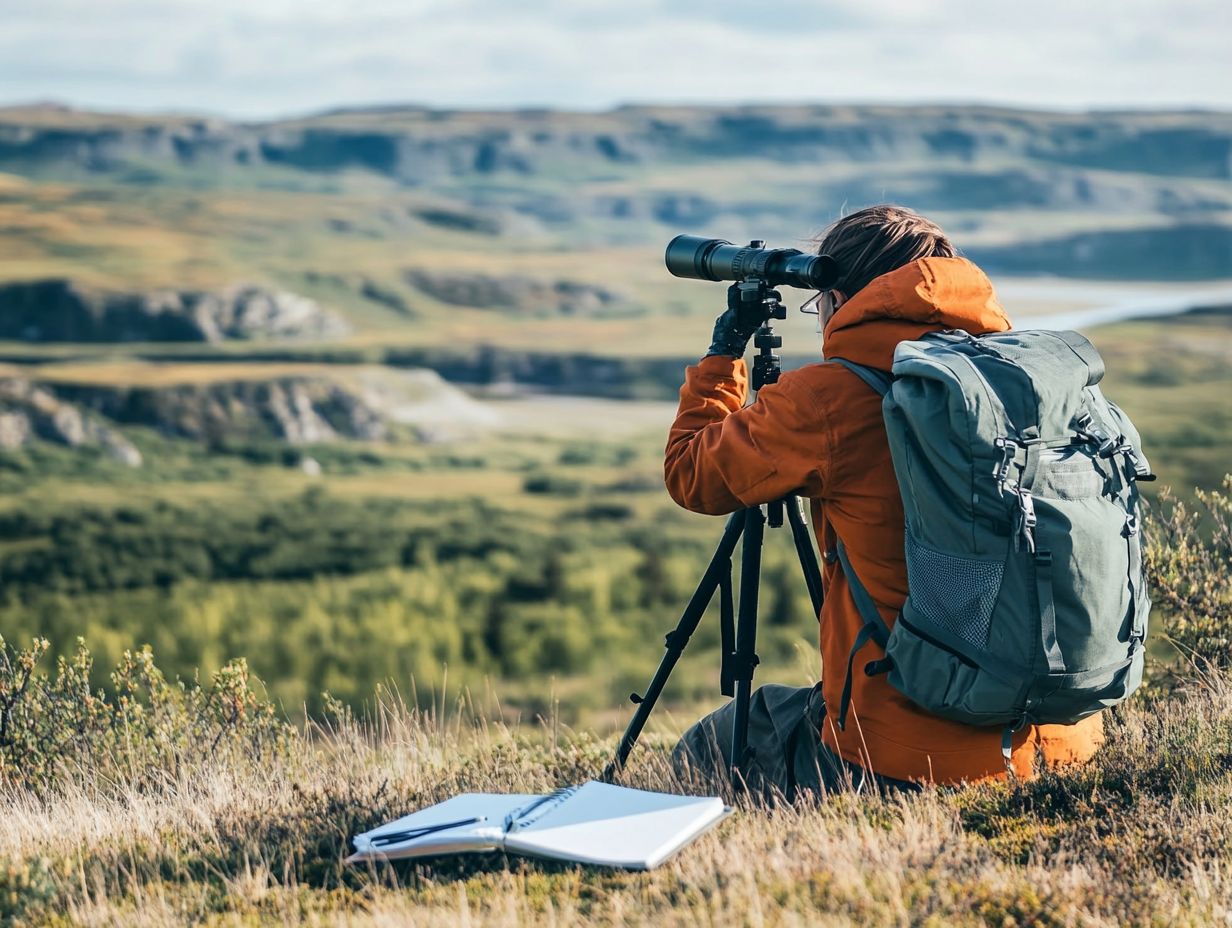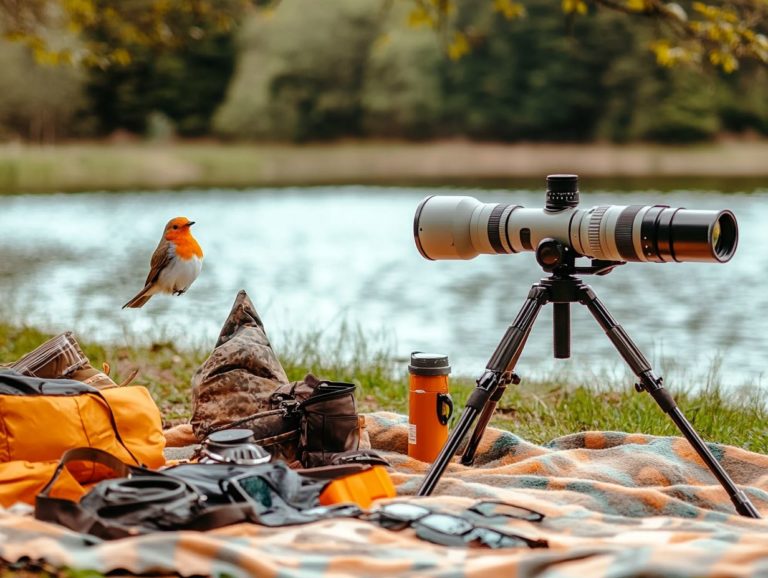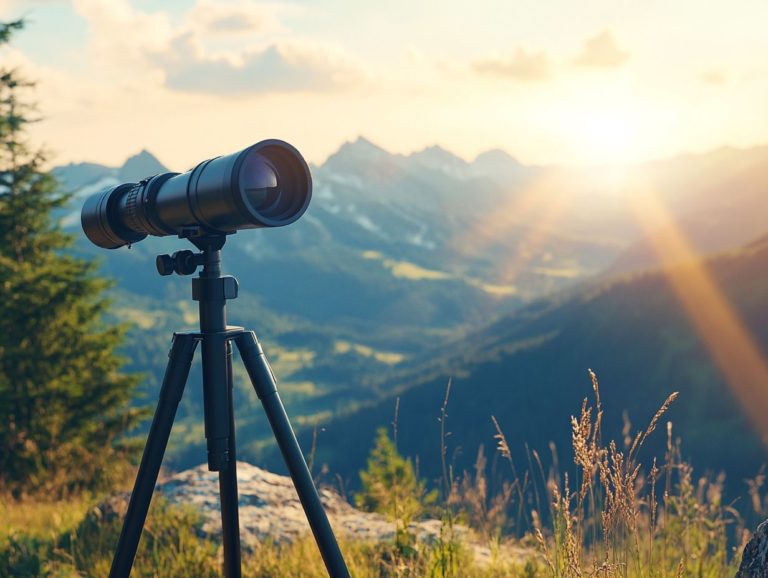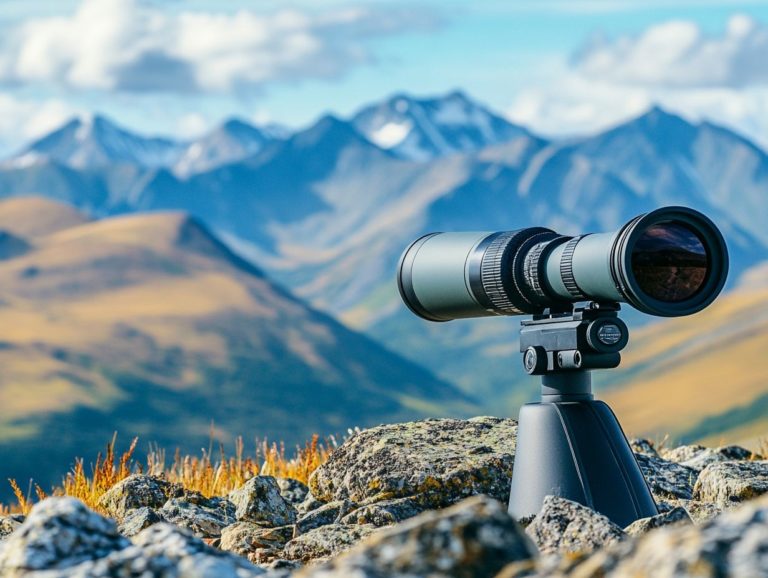5 Essential Tips for Using Your Spotting Scope
Whether you’re a birdwatching enthusiast, a hunter, or simply a nature lover, mastering the art of using a spotting scope can greatly enhance your outdoor experience.
Here are five essential tips to help you select the right equipment and maximize your viewing potential. From choosing the ideal location for your scope to understanding its key features and avoiding common pitfalls, these insights will serve as your guide.
Prepare to elevate your spotting skills and enjoy clearer, closer views of the captivating world around you.
Contents
Key Takeaways:

- Choose a spotting scope that suits your needs and budget for an optimal viewing experience.
- Use a tripod to ensure stability and avoid shaky images.
- Adjust the eyepiece and focus for a clear and sharp image.
1. Choose the Right Spotting Scope for Your Needs
Choosing the right spotting scope is crucial for outdoor enthusiasts. The right scope can significantly enhance your experience and the quality of your observations. Here are 5 reasons to invest in a high-quality spotting scope, whether you’re trying to catch a glimpse of that elusive bird or capturing breathtaking landscapes in stunning detail.
With various options available, including angled and straight-bodied designs, finding the perfect fit depends on your preferences and specific use scenarios. Angled models tend to be more comfortable for viewing at steep angles, while straight-bodied scopes offer a direct line of sight, making them ideal for quick spotting.
Key factors such as magnification, lens quality, and objective size (the diameter of the front lens) play a vital role in determining clarity and brightness. For instance, the Vortex Razor boasts superior optics perfect for long-distance viewing, while the Zeiss Conquest excels in low-light conditions. Understanding these features enables you to make informed choices that will elevate your outdoor adventures.
2. Use a Tripod for Stability
Using a tripod is essential when working with a spotting scope. It enhances image quality by minimizing vibrations, which can lead to eye fatigue during long wildlife observation sessions.
Selecting the right tripod is crucial, as different models cater to various needs. Lightweight aluminum tripods offer excellent portability, while heavier variants provide superior stability for those who prioritize steadiness.
The Benro tripod stands out with its robust design and features like anti-slip rubber feet, ensuring it stays firmly planted. This stability is especially important in windy conditions or on uneven terrain, helping capture clearer images and allowing for extended viewing without unwanted movement.
3. Adjust the Eyepiece and Focus
Adjusting the eyepiece and focus of your spotting scope is essential for optimal viewing. This customization tailors the fit to your eye, enhancing comfort and ensuring you enjoy a sharp, clear image without unnecessary strain.
When considering eyepiece options, weigh the advantages of fixed versus zoom eyepieces. Fixed eyepieces provide a consistent and often clearer view, while zoom models offer versatility for various distances.
Eyepiece relief is another critical factor, especially for glasses wearers, as it greatly impacts comfort during extended observations. Techniques like gently adjusting focus while keeping your eye steady can enhance image stability and clarity, leading to a more pleasurable viewing experience.
Finding the perfect combination of eyepiece and technique can elevate your spotting scope experience to new heights. For those just starting out, check out these tips for beginners to ensure you don’t miss out on the chance to truly experience nature!
Get your spotting scope ready and start exploring today!
4. Take Advantage of Zoom and Magnification

Using the zoom and magnification in your spotting scope can elevate your wildlife photography. You’ll capture distant and intricate subjects without sacrificing image quality.
With various magnification levels, you can switch between scanning landscapes and focusing on hidden animals. A higher zoom allows you to capture close-ups of majestic birds in flight.
Understanding the field of view is crucial. A wider field gives you a comprehensive perspective, helping you track fast-moving wildlife effectively.
Using a smartphone adapter to take pictures through your spotting scope opens exciting ways to document nature. You ll love how it enriches your experience and strengthens your bond with nature!
5. Use a Sunshade for Clearer Viewing
Using a sunshade can significantly enhance your viewing experience when using a spotting scope, especially in bright conditions. It reduces glare and improves image quality while protecting the lens coatings.
This is vital for observing in harsh sunlight, enabling clarity and focus on your subject without distractions. A sunshade also blocks direct sunlight and protects your equipment from sudden weather changes.
Many spotting scope sunshades have features like adjustable angles and lightweight, durable materials. They are easy to set up for quick outdoor adventures, optimizing visual conditions and enhancing your overall experience.
What Is a Spotting Scope and How Does It Work?
A spotting scope is a high-powered optical device crafted specifically for long-distance viewing. It enhances your outdoor experience, allowing you to observe wildlife and nature with impressive magnification and lens quality.
These scopes feature larger objective lenses that collect more light, resulting in brighter images and enhanced clarity, even in low-light conditions. Their design balances sturdiness and lightweight, making them easy to transport on all your adventures.
Spotting scopes come with various magnification levels, allowing you to observe intricate details from impressive distances. Unlike binoculars, which can limit your zoom, spotting scopes permit quick adjustments and offer steady views.
They are invaluable tools for birdwatching, hunting, and any form of wildlife observation.
What Are the Different Types of Spotting Scopes?
Spotting scopes come in a variety of types, including angled and straight body designs, each crafted for specific outdoor activities and personal preferences. Your choice affects how effectively you can engage in wildlife observation and photography.
For instance, straight body scopes provide a direct line of sight, making them advantageous for tracking fast-moving subjects. Angled scopes offer comfort during extended viewing sessions, especially when observing from a seated position.
If you’re a bird watcher, an angled model might make it easier to observe birds perched high in trees. Meanwhile, nature photographers may prefer the straightforward alignment of a straight scope for quick, decisive shots.
Understanding these nuances allows you to select the best equipment tailored to your specific activities.
What Are the Key Features to Look for in a Spotting Scope?

When selecting a spotting scope, prioritize key features like lens quality, objective size, and image stabilization technology. Understanding 5 things you didn’t know about spotting scopes can also help ensure optimal performance in various weather conditions and enhance your overall experience.
Lens coatings are equally important as they significantly impact the scope’s ability to transmit light and reduce glare. High-quality coatings boost brightness and clarity, giving you better visibility during twilight moments when outdoor enthusiasts often need it most.
The objective diameter, or the size of the front lens, is critical. Larger diameters allow for increased light collection, resulting in clearer images at greater distances.
Robust build quality is crucial as it guarantees durability against the elements and enhances stability during use. This ensures you can enjoy crisp, shake-free observations no matter where your adventures take you.
How Can You Maintain and Care for Your Spotting Scope?
Proper maintenance and care are essential for prolonging your spotting scope’s lifespan and ensuring optimal performance, particularly in various weather conditions. Dirt and moisture can severely impair lens quality and your viewing experience.
To keep your scope in top shape, regular lens cleaning is crucial. Use a soft, lint-free cloth along with a specialized lens cleaner to effectively eliminate dust and smudges without scratching the surface.
When not in use, store your spotting scope in a cool, dry location, ideally within a protective case that guards against temperature fluctuations and humidity. For outdoor adventures, consider setting up your spotting scope with lens covers to shield against rain and dust; even brief exposure to moisture can lead to fogging or mildew.
By proactively addressing these concerns, you’ll enhance the functionality and clarity of your optics, ensuring your spotting scope is always ready for your next adventure. For more information, check out the best practices for carrying your spotting scope.
What Are the Common Mistakes to Avoid When Using a Spotting Scope?
Many users fall into common traps when using a spotting scope, leading to less-than-stellar image quality and a frustrating viewing experience. To improve your results, check out these tips for using spotting scopes in low light and consider factors like improper focus adjustments, overlooking eyepiece options, and neglecting the importance of a stable setup.
These issues can dampen your ability to fully appreciate wildlife in their natural environments. As a beginner, you might rush your focus adjustments, washing out essential details. Meanwhile, seasoned enthusiasts may forget to secure their tripod, resulting in shaky images.
To truly elevate your experience, take your time during setup. Ensure everything is well-aligned and stable. Experimenting with different eyepiece options can unlock a clearer view and enhanced zoom capabilities, allowing you to immerse yourself in observation and capture even the most elusive creatures in stunning detail.
How Can You Improve Your Spotting Scope Skills for Better Viewing?
Improving your spotting scope skills can elevate your wildlife observation experience, enabling you to capture breathtaking images and appreciate nature’s beauty in stunning detail. For effective techniques, consider these 5 tips for spotting birds with a scope, all while minimizing eye fatigue during extended viewing sessions.
Familiarizing yourself with the various settings and features of your spotting scope allows you to fine-tune your equipment for different environments. To enhance your experience, learn how to make the most of your spotting scope setup. Practicing specific techniques for digiscoping is also beneficial; this technique merges digital photography with your spotting scope, enabling you to obtain high-quality images of distant wildlife.
Understanding animal behavior is essential; knowing the best times to observe and the habits of specific species will significantly enhance your chances of successful sightings. By combining these strategies, you’ll ensure a rewarding and enriching wildlife watching experience.
Frequently Asked Questions

What are the 5 Essential Tips for Using Your Spotting Scope?
Here are the five essential tips for using your spotting scope:
1) Familiarize yourself with the scope’s features. 2) Use a tripod for steady viewing. 3) Adjust the focus and magnification. 4) Use the sunshade to reduce glare. 5) For more tips, check out these ways to enhance your spotting scope experience before your trip.
Why is it important to know your scope’s features?
Knowing your scope’s features helps you use it effectively. You’ll learn how to adjust settings, swap eyepieces, and use any special features.
How does a tripod enhance viewing?
A tripod stabilizes your scope, reducing shaky images for a clearer view. This is important at high magnifications, where small movements can affect image quality.
How do I adjust focus and magnification?
To focus, look through the eyepiece and turn the focusing knob until the image is clear. Change magnification by using the adjustment part or swapping eyepieces.
What benefits does a sunshade provide?
A sunshade reduces glare, making it easier to see your target. It’s especially useful when viewing bright objects like the sun or reflective surfaces.
Why should I practice with my spotting scope?
Practice is key to unlocking your scope’s full potential! By experimenting with different settings and objects, you’ll gain confidence and enhance your viewing experience.






